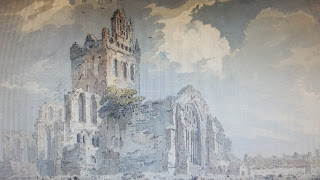Petworth House is a grand old pile in West Sussex. For centuries it was the seat of the noble Percy family and now it's owned by the National Trust. The pretty, and pretty extensive, grounds are home to the largest herd of fallow deer in England and the baroque country house itself contains Grinling Gibbons' wood-carvings and a large, somewhat dusty looking, art collection housing many works by JMW Turner who had a studio in the building.
Raymond Noire had invited me along to see their temporary exhibition, Turner & the age of British Watercolour, and I'd gratefully accepted. The show was being hosted in one medium sized room in the servant's quarters. An area I'd probably feel more at home in anyway.
I'm a huge fan of Turner but I've never been overenamoured with watercolours so it was very much a game of two halves for me. Whilst I could appreciate the talent, the subject matter, the views, and the stories behind the works on show some of it was, undoubtedly, a little chocolate boxy. Like something my gran would've had on a biscuit tin.
Split into two sections, British Life and Landscape and The Lure of the Continent, the first work to really catch my eye was Turner's A First Rate Taking In Stores (1818, below). It showed how the master was able to imbue his watercolours with almost blinding light. So much does it capture the essence of its maritime scene that you can almost feel the salty spray of the brine against your skin.
It's quite a contrast to the lugubrious twilight of John Glover's Lancaster (1820). While Turner celebrates the sun being high in the sky Glover gives us the feeling of the day coming to an end and, as such, it's a mournful, evocative rendering of an early 19c landscape.
John Sell Cotman was of the Norwich school but, in the tradition of the Grand Tour, he ventured much further afield. Falaise, Normandy, Entrace to the City (1823) makes good use of the pale houses and bleached lights of the continent. Further south, in Switzerland, Turner painted the Great Falls of Reichenbech (in 1804) where Moriarty fell to his death after a fight with Sherlock Holmes in Conan Doyle's The Final Problem nearly ninety years later.
Even more impressive, both scenically and painterly, is John Robert Cozens' In the Canton of Unterwalden (1776-1778). These Swiss peaks given a romantic gloss that's not too far from Cozens' German contemporary Caspar David Friedrich.
The Napoleonic Wars at the start of the nineteenth century did their best to ruin the jolly travels (or working tours) of these artists but the exhibition has been curated so that it's fairly difficult to get any feeling of a time frame, or any sense of artistic development, from it. There's plenty of nice paintings here but they don't really tell a story.
Richard Parkes Bonington (L'Institut, Paris, 1828, above) and Thomas Girtin (Palace of the Louvre 1801-1802, below) both died very young. In fact both became members of the 27 club. Bonington in 1828 of tuberculosis whilst Girtin's death was variously reported as being due to either asthma or 'ossification of the heart'. Turner had been a great admirer of Girtin, particularly, and had said of the man born in the same year as him, 1775, that had he "lived I should have starved". Bonington was born about six weeks before Girtin died and during a spell in France, where he befriended Eugene Delacroix, came under the influence of French painters who themselves had been influenced by Girtin. Ideas flowed freely back and forth across the channel as well they should.
Turner himself lived to a ripe old age. Back in Switzerland in 1841 he painted Town and Lake of Thun which shows his later, more gauzy, dreamy, proto-impressionist style to great effect. Artists were now painting as far afield as the Spanish city of Toledo but, oddly, the exhibition takes us back nearly half a century to Girtin's Jedburgh Abbey (1798-99). It's pleasant enough but it doesn't seem to be one of Girtin's best works and it seems a bit anticlimactic once we've seen late Turner nearing full bloom.
William Daniell's Westminster Bridge from the South, 1804, is a charming domestic piece and I enjoyed trying to square it with my knowledge of the area now. Where would Waterloo station be? What about the London Eye? The Houses of Parliament?
Turner painted the Bishop's Palace in Salisbury in 1799 when he was just 24 years old. That's nothing. There's a painting here he completed aged just sixteen. Having been both a prodigy and a man who continued painting, often radically, into his dotage there's a lot of Turner works spread around various galleries of London and the south. These weren't his best by any stretch but they were instructive in building up a clearer picture of the man and his methods and the inclusion of the likes of Girtin, Bonington, and Cozens helped place him within the wider context of the time. He's often seen as, and often was, a maverick. But sometimes, it seems, he was just one of many accomplished painters that were active as the eighteenth century turned into the nineteenth.














No comments:
Post a Comment